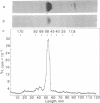Abstract
Trypanosoma brucei brucei incorporates D-[3H]mannose into protein in vitro in a medium we describe here. The label appears entirely in glycoproteins with approximately 90% in the major variable surface coat glycoprotein (VSCG). Incorporation is linear for 60 min and usually continues for an additional 30 min although at a decreased rate. In the same medium incorporation of L-[14C]serine is linear for 90 min. Incorporation of [3H]mannose is completely inhibited by tunicamycin at concentrations above 100 ng/ml, indicating that the label is being added as part of an N-linked oligosaccharide. This is reflected by a 5% decrease in the apparent molecular weight of VSCG on sodium dodecyl sulfate/polyacrylamide gel electrophoresis. Cycloheximide inhibits incorporation of both mannose and serine, although the rates and extent of inhibition differ. Based on the effects of tunicamycin or cycloheximide on incorporation of either precursor, we suggest that N-linked glycosylation occurs subsequent to synthesis of the VSCG polypeptide.
Full text
PDF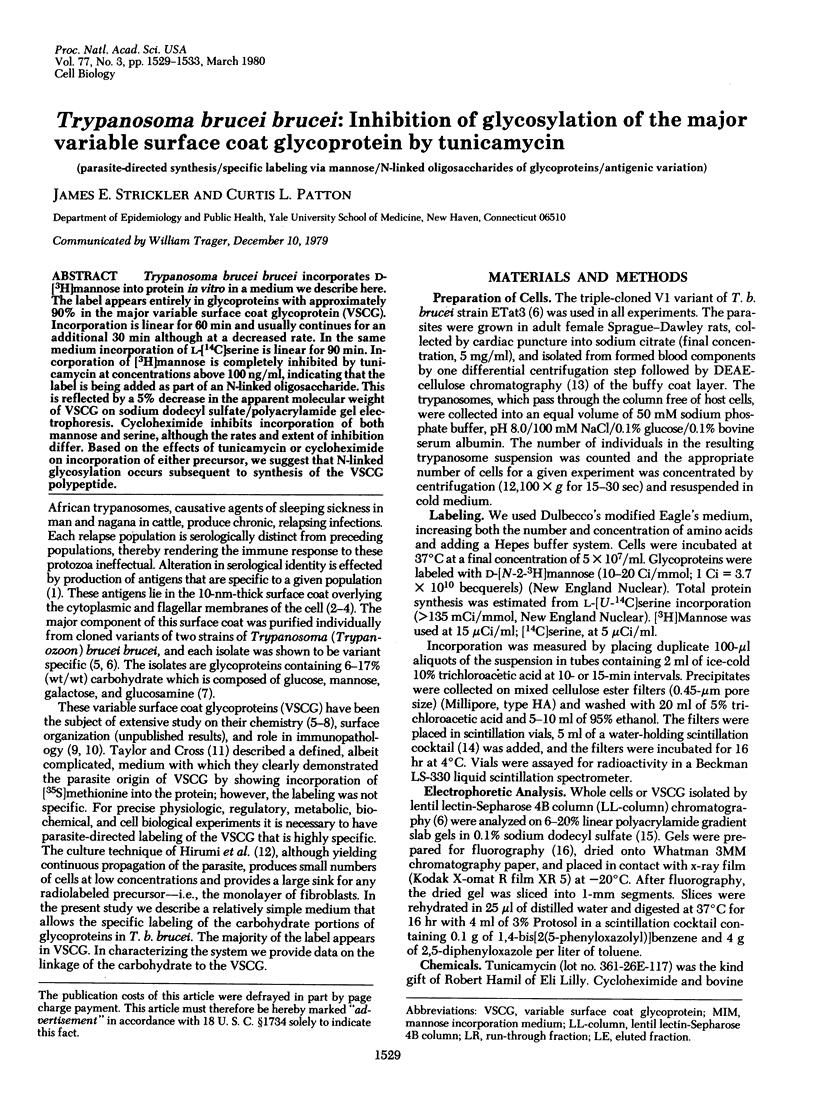
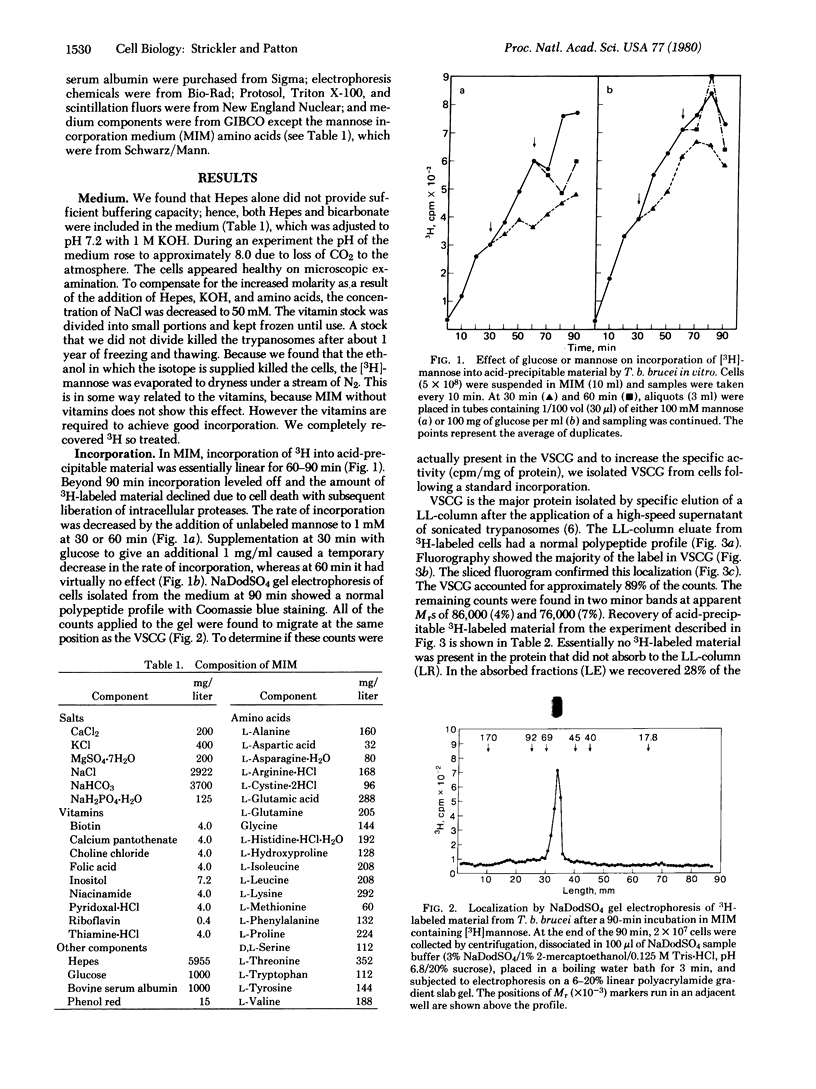
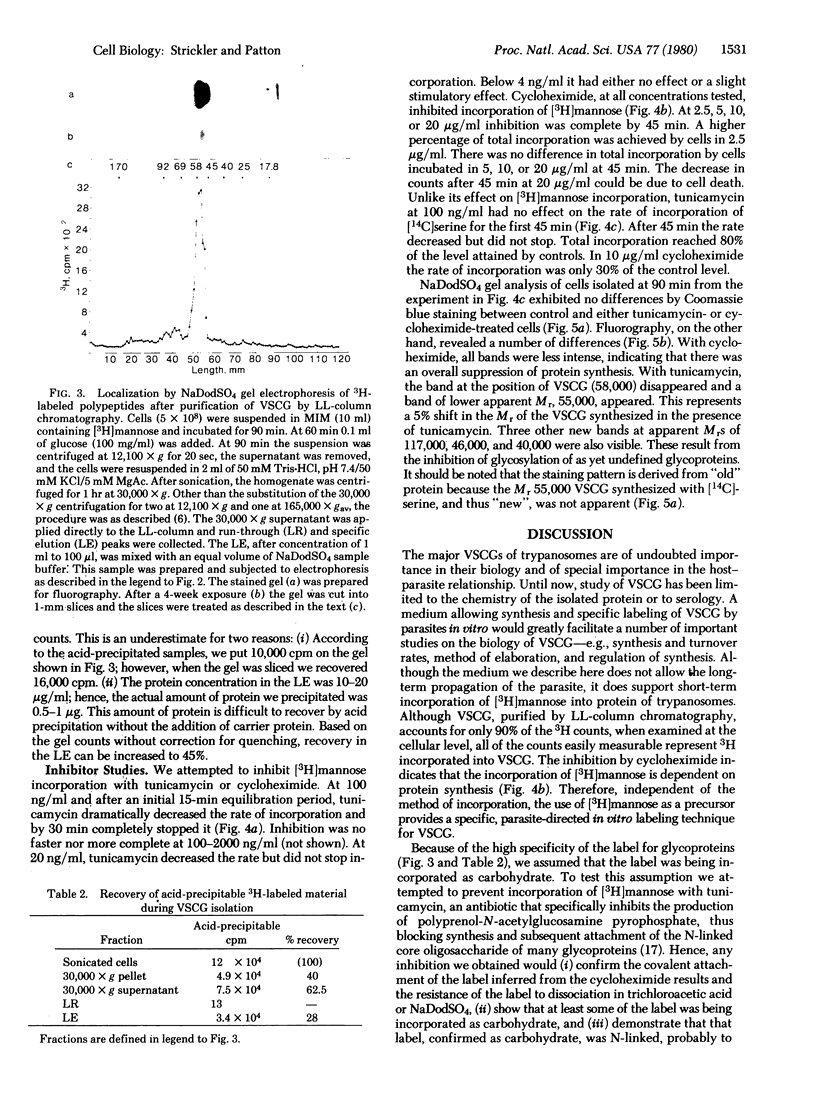
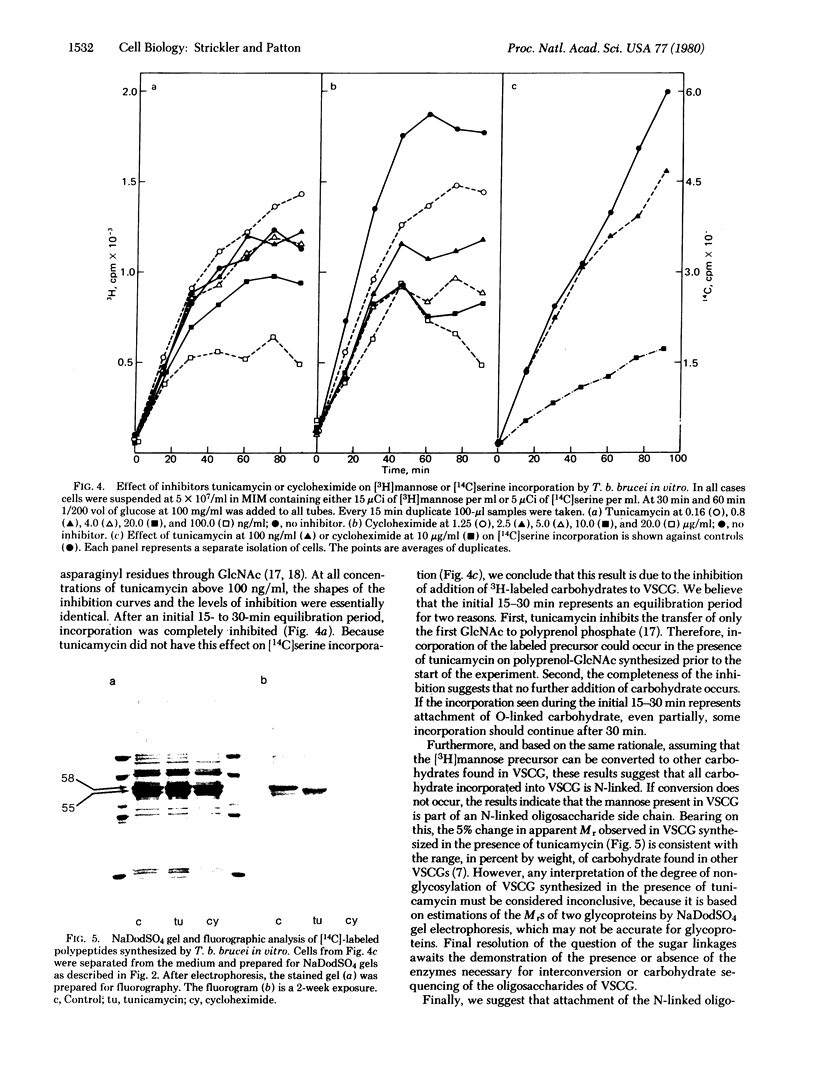
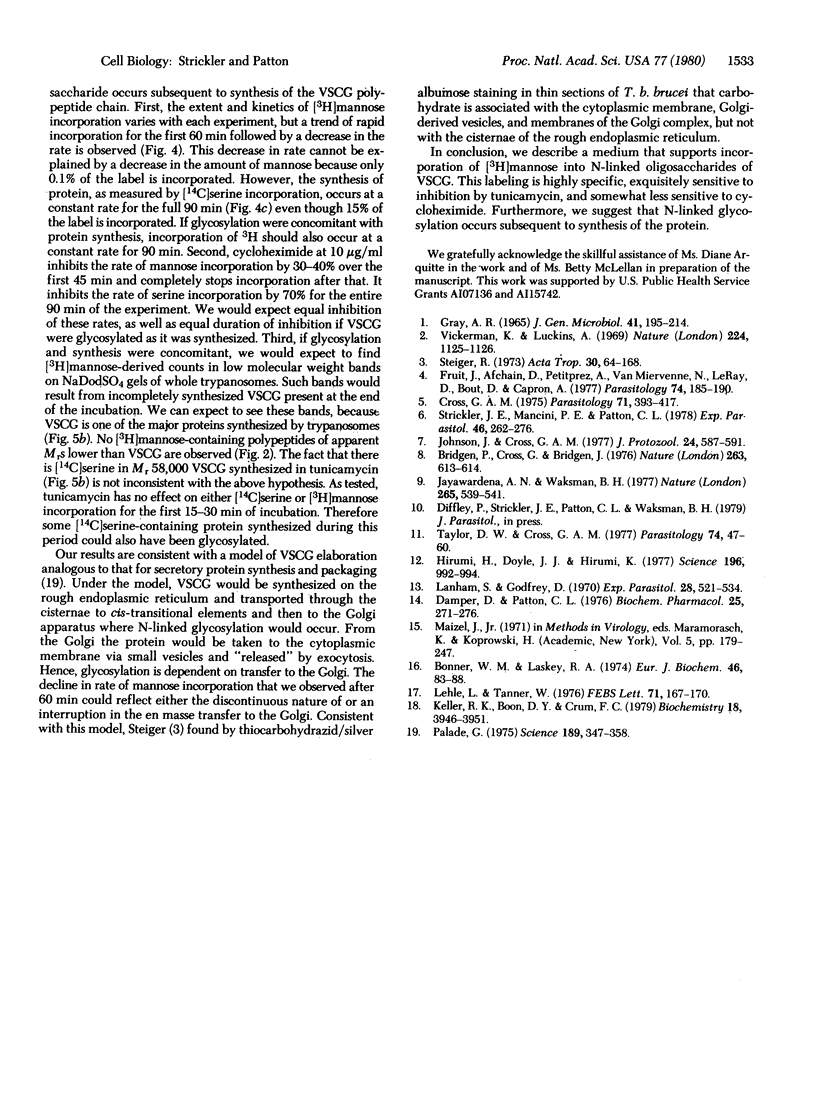
Images in this article
Selected References
These references are in PubMed. This may not be the complete list of references from this article.
- Bonner W. M., Laskey R. A. A film detection method for tritium-labelled proteins and nucleic acids in polyacrylamide gels. Eur J Biochem. 1974 Jul 1;46(1):83–88. doi: 10.1111/j.1432-1033.1974.tb03599.x. [DOI] [PubMed] [Google Scholar]
- Bridgen P. J., Cross G. A., Bridgen J. N-terminal amino acid sequences of variant-specific surface antigens from Trypanosoma brucei. Nature. 1976 Oct 14;263(5578):613–614. doi: 10.1038/263613a0. [DOI] [PubMed] [Google Scholar]
- Cross G. A. Identification, purification and properties of clone-specific glycoprotein antigens constituting the surface coat of Trypanosoma brucei. Parasitology. 1975 Dec;71(3):393–417. doi: 10.1017/s003118200004717x. [DOI] [PubMed] [Google Scholar]
- Damper D., Patton C. L. Pentamidine transport in Trypanosoma brucei-kinetics and specificity. Biochem Pharmacol. 1976 Feb 1;25(3):271–276. doi: 10.1016/0006-2952(76)90213-6. [DOI] [PubMed] [Google Scholar]
- Gray A. R. Antigenic variation in a strain of Trypanosoma brucei transmitted by Glossina morsitans and G. palpalis. J Gen Microbiol. 1965 Nov;41(2):195–214. doi: 10.1099/00221287-41-2-195. [DOI] [PubMed] [Google Scholar]
- Hirumi H., Doyle J. J., Hirumi K. African trypanosomes: cultivation of animal-infective Trypanosoma brucei in vitro. Science. 1977 May 27;196(4293):992–994. doi: 10.1126/science.558652. [DOI] [PubMed] [Google Scholar]
- Jayawardena A. N., Waksman B. H. Suppressor cells in experimentally trypanosomiasis. Nature. 1977 Feb 10;265(5594):539–541. doi: 10.1038/265539a0. [DOI] [PubMed] [Google Scholar]
- Johnson J. G., Cross G. A. Carbohydrate composition of variant-specific surface antigen glycoproteins from Trypanosoma brucei. J Protozool. 1977 Nov;24(4):587–591. doi: 10.1111/j.1550-7408.1977.tb01020.x. [DOI] [PubMed] [Google Scholar]
- Keller R. K., Boon D. Y., Crum F. C. N-Acetylglucosamine- 1 -phosphate transferase from hen oviduct: solubilization, characterization, and inhibition by tunicamycin. Biochemistry. 1979 Sep 4;18(18):3946–3952. doi: 10.1021/bi00585a016. [DOI] [PubMed] [Google Scholar]
- Lanham S. M., Godfrey D. G. Isolation of salivarian trypanosomes from man and other mammals using DEAE-cellulose. Exp Parasitol. 1970 Dec;28(3):521–534. doi: 10.1016/0014-4894(70)90120-7. [DOI] [PubMed] [Google Scholar]
- Lehle L., Tanner W. The specific site of tunicamycin inhibition in the formation of dolichol-bound N-acetylglucosamine derivatives. FEBS Lett. 1976 Nov 15;72(1):167–170. doi: 10.1016/0014-5793(76)80922-2. [DOI] [PubMed] [Google Scholar]
- Palade G. Intracellular aspects of the process of protein synthesis. Science. 1975 Aug 1;189(4200):347–358. doi: 10.1126/science.1096303. [DOI] [PubMed] [Google Scholar]
- Steiger R. F. On the ultrastructure of Trypanosoma (Trypanozoon) brucei in the course of its life cycle and some related aspects. Acta Trop. 1973;30(1):64–168. [PubMed] [Google Scholar]
- Strickler J. E., Mancini P. E., Patton C. L. Trypanosoma brucei brucei: isolation of the major surface coat glycoprotein by lectin affinity chromatography. Exp Parasitol. 1978 Dec;46(2):262–276. doi: 10.1016/0014-4894(78)90140-6. [DOI] [PubMed] [Google Scholar]
- Taylor D. W., Cross G. A. The synthesis of a variant-specific antigen by Trypanosoma brucei in vitro. Parasitology. 1977 Feb;74(1):47–60. doi: 10.1017/s0031182000047521. [DOI] [PubMed] [Google Scholar]
- Vickerman K., Luckins A. G. Localization of variable antigens in the surface coat of Trypanosoma brucei using ferritin conjugated antibody. Nature. 1969 Dec 13;224(5224):1125–1126. doi: 10.1038/2241125a0. [DOI] [PubMed] [Google Scholar]




